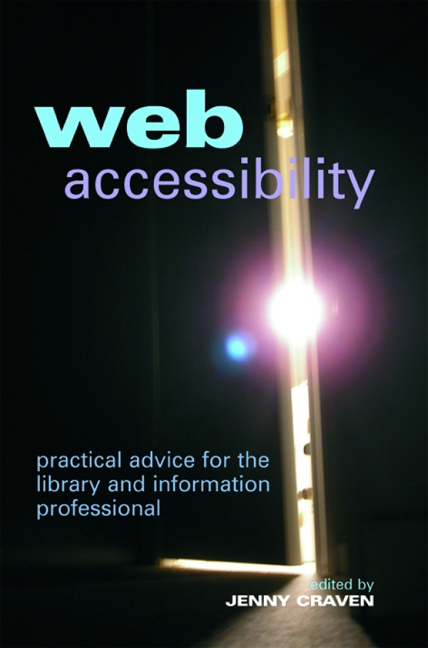Book contents
- Frontmatter
- Contents
- Contributors
- 1 Introduction
- 2 Tools used for widening access to the web
- 3 Design for All – how web accessibility affects different people
- 4 The importance of web accessibility
- 5 Accessibility advice and guidance
- 6 Accessibility evaluation and assessment
- 7 Issues for library and information services
- 8 Design for All in the library and information science curriculum
- 9 Best practice examples of web accessibility
- 10 Web accessibility in the future
- Index
6 - Accessibility evaluation and assessment
Published online by Cambridge University Press: 08 June 2018
- Frontmatter
- Contents
- Contributors
- 1 Introduction
- 2 Tools used for widening access to the web
- 3 Design for All – how web accessibility affects different people
- 4 The importance of web accessibility
- 5 Accessibility advice and guidance
- 6 Accessibility evaluation and assessment
- 7 Issues for library and information services
- 8 Design for All in the library and information science curriculum
- 9 Best practice examples of web accessibility
- 10 Web accessibility in the future
- Index
Summary
Introduction
Evaluating the accessibility of a website is an important part of accessible web design, whether as part of a new design project, or an assessment of an existing resource for potential barriers. While the goal of an accessibility evaluation or audit is simple – to identify any barrier that may limit or prevent a disabled person from using the subject website for its intended purpose – the diversity of user needs, browsing set-ups and functionality provided by web resources can make evaluation complex and challenging. Thankfully, there are many tools and techniques that can help people without significant accessibility expertise and experts alike to identify where accessibility problems may exist in a website.
Finding the problems is only half the story, though, as there is also the matter of acting on the results of the evaluation. In other words, how can we use the evaluation findings to help improve the accessibility of the resource in question? This chapter looks at effective techniques for evaluating a website's accessibility, and how these can best be presented in a way that helps those responsible for removing or reducing the barriers identified.
Evaluation aims
The immediate aim of a website accessibility evaluation should be to uncover all true instances of where a disabled person may have difficulty using or be unable to use the site for its intended purpose and to avoid reporting instances of barriers that do not actually adversely affect accessibility. Results are particularly likely to be relevant if the evaluation looks at the accessibility of the tasks supported by the website, rather than individual pages. This more holistic approach focuses on how users will be interacting with the site, which in most cases will be a flow through a series of pages rather than visiting pages in isolation (Kelly, Phipps and Swift, 2004) (See also section on ‘Building on the WAI approach’ in Chapter 10).
The status of the website under review may influence what evaluation techniques are used, and how the results are reported. Ideally, an accessibility evaluation will take place early on in the design and development of a web - site, and will be repeated periodically as things evolve.
Information
- Type
- Chapter
- Information
- Web AccessibilityPractical Advice for the Library and Information Professional, pp. 73 - 96Publisher: FacetPrint publication year: 2008
